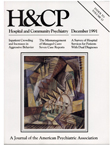A Survey of Hospitals in New York State Treating Psychiatric Patients With Chemical Abuse Disorders
Abstract
Eighty-eight of 143 hospitals in New York State providing psychiatric inpatient treatment responded to a mailed questionnaire designed to determine the size of three subgroups of chemical abusers—alcohol abusers, drug abusers, and polychemical abusers—among inpatients with psychiatric diagnoses, as well as the availability of services for these patients. Data for New York City and its metropolitan area were analyzed separately. In 1987 almost one-third of psychiatric admissions both in and outside the metropolitan area had comorbid chemical abuse disorders. Seventy-five percent of patients in the metropolitan area with comorbid chemical abuse had a drug abuse disorder; in rural areas 88 percent of patients with chemical abuse disorders abused alcohol. Both hospital- and community-based aftercare services, especially in the metropolitan area, were less available to psychiatric patients with chemical abuse than to patients without these disorders.
Access content
To read the fulltext, please use one of the options below to sign in or purchase access.- Personal login
- Institutional Login
- Sign in via OpenAthens
- Register for access
-
Please login/register if you wish to pair your device and check access availability.
Not a subscriber?
PsychiatryOnline subscription options offer access to the DSM-5 library, books, journals, CME, and patient resources. This all-in-one virtual library provides psychiatrists and mental health professionals with key resources for diagnosis, treatment, research, and professional development.
Need more help? PsychiatryOnline Customer Service may be reached by emailing [email protected] or by calling 800-368-5777 (in the U.S.) or 703-907-7322 (outside the U.S.).



